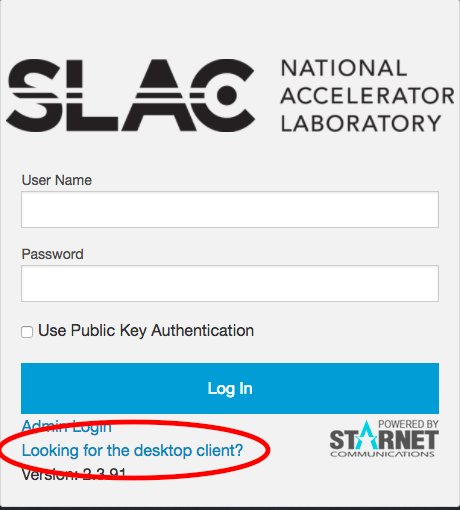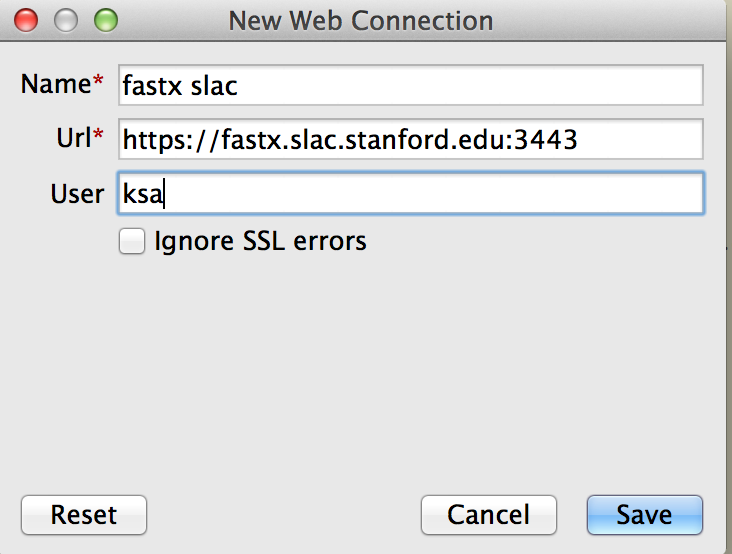...
Connecting to FastX using your Web Browser
The easiest way to use FastX is through your Web browserFastX is unique in that a client application is not required. If you do not wish to download the FastX client, you can use any web browser to create to access your sessions. All modern browsers are supported, including Firefox, Safari, Chrome, and IE 10+ (or your smart phone).
- Go to the SLAC FastX web login page: https://fastx.slac.stanford.edu:3443
- Log in with your SLAC Unix username and password.
Do not check the Public Key Authentication option – that will not work well since it will not give you an AFS token.
To start a new session, click on the plus box:
Inside the command box, you can start an xterm window and connect to a SLAC interactive login pool machine like this. You can replace rhel6-64 with the hostname of your own group's interactive login machine if you have one. Next to the command box, make sure 'multiple' is chosen (it's a drop down menu; the other choice is single). Multiple means "multiple window mode" which allows you to move and resize your X client windows inside your browser window.
xterm -e ssh rhel6-64.slac.stanford.edu
If you want to run your own window manager inside the browser client (instead of the default window manager you get when you run in "multiple window mode"), then choose "single window mode". Type the following two commands inside your xterm window if you want to run the "twm" window manager (the xsetroot command just makes your desktop background a more pleasing color):
twm &
xsetroot -solid greyOther lightweight window managers include fvwm2, fluxbox, and xfce. If these are not installed, you can ask unix-admin to install them (they are part of the EPEL repository). It is possible to run an entire GNOME or KDE session (using the commmands 'gnome-session' or 'startkde'). In general, the best way to use FastX is to only start the specific applications you need, without using an entire desktop environment. But you are free to experiment to find the best solution for you.
Now you can start your Linux X applications by typing the commands inside your xterm window. For example:
gimp &
gvim &
gnome-terminal &
/afs/slac/package/anaconda/anaconda3/bin/spyder &
As always, your SLAC Unix AFS token needs to be renewed every 25 hours. If your AFS token expires, then you will not be able to write files into your AFS home directory. When you reconnect to your session later, the 'qtoken' command will quickly tell you if you have a current AFS token or not. If your AFS token as expired, then use the 'kinit' command to get a new Kerberos ticket and AFS token.
/usr/local/bin/qtoken
/usr/local/bin/kinit
...
- Go to this URL: https://fastx.slac.stanford.edu:3443
- If you are already logged in, you need to log out to see the link for the desktop client.
- Log and and look at the lower right corner for the link that says Click on the link that says: "Desktop client"
- Or, directly download the client application from this URL:
https://www.starnet.com/fastx/current-client " Looking for the desktop client?"
- Download and start the desktop client.
- Click the + (plus) sign in the upper right corner to configure a new connection.
- Select Web (which is https port 3443) when given the choices of Web or SSH. We have been noticing problems reconnecting to sessions created using the SSH Desktop connection. This has been reported to FastX support.
- Enter these values when you create a new Web client connection: (replace 'ksa' with your username):
- If you see a checkbox that says "Force SSH Authentication", click that checkbox.
- Click the Save button.
- Double click on your new saved connection.
- You can start a new session using the same instructions the the above session for "Connecting to FastX" – click the + (plus) icon.
- When you start a new session using the desktop client, you have a choice for Window mode: Multiple or Single. If you choose single window mode, all of your Linux X applications will be run inside one resizable single window (as opposed to the multiple seamless floating windows you get if you choose multiple mode).
You can reconnect to one of your already running sessions by double clicking on it under the Name column. It could take several seconds for your saved session to appear.
You should also see any sessions you already have running that you may have started in a browser connection to FastX.
...

